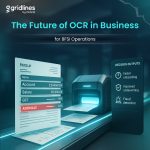In the financial era we live in today, showing proof of your income is not about mere forms—it’s about building trust and stability. From getting a loan or credit card to getting a place to rent or even government benefits, proof of income allows institutions and businesses to make smart choices while you gain the services that you require.
Yet, verifying income has historically been a tedious process. Salaries come in different forms, freelancers and gig workers earn irregularly, and documents vary widely in format and authenticity. The good news? Platforms like Gridlines are modernizing income verification, making it faster, more accurate, and more secure.
This blog explores what proof of income is, why it matters, the challenges with traditional methods, and how modern verification works.
What Is Proof of Income?
Proof of income is any document or record that verifies how much money an individual makes over a given time. It’s not merely presenting money—it’s about proving reliability and financial security.
For landlords, lenders, businesses, and government institutions, this evidence is the foundation for decision-making, compliance, and assessing risk. For individuals, having adequate proof of income guarantees access to finance, loans, and rentals without complications or undue delay.
Why Proof of Income Is Significant
Verification of income is critical in several situations:
- Loans and Credit: Banks and financial institutions require proof of income to determine whether an applicant can repay a loan. It influences the loan amount, interest rate, and repayment terms.
- Renting Homes: Landlords use proof of income to ensure potential tenants can afford rent and pay on time, reducing the risk of default.
- Verification of Employment: Certain employers can verify past income, particularly for high-level positions or compliance-oriented positions, to provide equitable pay and avoid discrepancies.
- Government Assistance: Much social assistance and entitlement is based on income as a determining factor for eligibility.
- Financial Institutions: Credit card issuers check income to offer reasonable credit limits and avoid overextension.
Effectively, income verification instills credibility and diminishes financial risk for individuals and organizations alike.
Common Forms of Proof of Income Documentation
Based on employment status and income origin, various documents may act as proof:
- Bank Statements
Bank statements demonstrating periodic deposits or payments from clients are essential for freelancers, contractors, and self-employed individuals. They give an open view of the flow of income and account balance.
- Income Tax Returns (ITRs)
Tax returns document income reported to taxing authorities. Tax returns are legal documents and usually the most accurate source of proof of income, although they might not provide up-to-date earnings.
- Pay Slips / Salary Slips
Pay slips provide detailed information regarding earnings, deductions, and year-to-date earnings. They’re extremely helpful for salaried staff.
- Employer-issued Income Letters
If your income is periodic, commission, or based on bonuses, an official income letter from the employer can substantiate your financial situation.
- Pension or Social Security Statements
Retirees or some government workers can submit statements of pension payout or social security benefits.
- Court-ordered Payments
Alimony or child support can be used as evidence of income for those with informal employment or wages.
Challenges of Traditional Income Verification
Although evidence of income is essential, the conventional verification process has several challenges:
- Varied Document Formats: Various banks, employers, and government offices print documents in different formats, making it time-consuming to cross-check them manually.
- Potential Fraud: Without computerized checks, forged or altered documents can go undetected.
- Time-Consuming Procedures: Manual checking can take days or weeks, holding up loan, rental, or employment approvals.
- Privacy Issues: Processing sensitive financial information demands secure procedures and user confidence.
These issues can irritate applicants and cause inefficiencies in businesses.
Advanced Proof of Income Verification
Due to the advancement of technology, companies such as Gridlines have revolutionized income verification to be a smooth, secure, and quick procedure. Here’s how new verification is done:

1. Multi-Source Evidence Aggregation
Contemporary platforms are able to gather numerous documents from candidates—bank accounts, pay slips, employer statements, and tax returns—and compile them into one solid, integrated verification record. This guarantees correctness and completeness.
2. Optical Character Recognition (OCR)
OCR technology enables systems to read pertinent information from digital captures or scanned images. This implies that salary slips, tax returns, or bank statements can be read automatically and processed, reducing time and errors.
3. Data Normalization
Income can be presented in various forms—monthly, quarterly, or annual. Advanced verification tools standardize this information into a uniform format, enabling firms to compare candidates fairly and reliably.
4. AI-Driven Fraud Detection
AI technology identifies discrepancies, possible document alteration, or abnormal patterns. This lowers risk and ensures that only verified income is taken into account in making decisions.
5. Real-Time Verification
Rather than waiting days or weeks, current platforms deliver verification in minutes. This accelerates loan approvals, rental contracts, and hiring for employment.
6. Consent-First Approach
Everything is consent-based data gathering and verification, ensuring privacy and compliance with regulatory requirements. All activities are logged and audit trail, building trust between users and institutions.
How Salary Slip OCR Works
Automated OCR of salary slips is a well-procedured process:
- Document Capture: Scan or photograph the salary slip.
- Image Processing: Process the image for correct data extraction.
- Text Extraction: Automated algorithms recognize and pull out major fields like gross pay, deductions, and net income.
- Data Structuring: Structure the pulled information into easy-to-read, structured formats.
- Verification: Compare data against rules or external sources for correctness.
- Results Generation: Generate a verified income report, flagging discrepancies if any.
This approach significantly slashes manual effort while boosting speed and accuracy.
Why Businesses Depend on Proof of Income
Proof of income enables companies to:
- Evaluate Risk: Confirm applicants’ ability to cover financial responsibilities.
- Avoid Fraud: Confirm reported income against actual income.
- Comply: Conform to law and industry requirements.
- Make Fast Decisions: Facilitate quicker approvals and onboarding.
- Segment Customers: Provide products or services based on confirmed income levels.
Through consistent verification, companies save time, lower operational expense, and enhance customer trust.
Conclusion
Proof of income is not about formality—it’s about measuring trust, financial stability, and dependability. Today’s platforms such as Gridlines accelerate income verification, making it safer, more accurate, and benefiting individuals and companies alike.
For individuals, having proper documents in order facilitates easy loan sanctions, rental contracts, and monetary transactions. For organizations, going digital with verification technologies lowers risk, enhances operational effectiveness, and enhances compliance.
In the fast-paced financial times of today, income proof is not just a necessity—it’s a competitive edge.





Leave a Reply